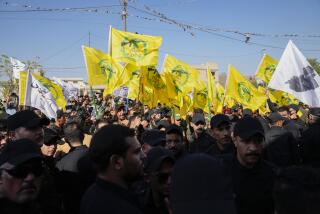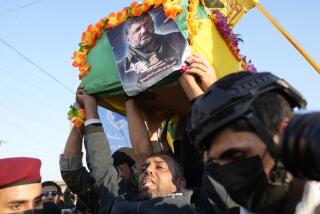Iranian Rebels Get a New Lease on Life
KARAMA, Jordan â Aid workers called them the Persians, but everyone else in the shabby refugee camp here near the Jordan-Iraq border knew them simply as the moujahedeen.
For two weeks, about 60 of them occupied tents in a dust-blown no-manâs land beside 800 Kurds who had fled as Saddam Husseinâs regime collapsed. The Kurds, who were Sunni Muslims, were running from the Shiites, but the moujahedeen were running from everyone.
âWe all knew who they were. We knew them from Baghdad, but in Baghdad they had uniforms,â recalled Mohammed Said, who lived in a tent near them. âWe donât like them, though. Nobody liked the moujahedeen.â
The Moujahedeen Khalq, or Peopleâs Holy Warriors, is an Iranian exile group that is fighting the Tehran government and had allied itself with Hussein. The group has killed U.S. citizens, and it took part in the takeover of the U.S. Embassy in Tehran in 1979. The State Department lists the group as a terrorist organization.
Ousted from Iran for its Marxist ideology after the 1979 Islamic Revolution, the group was given bases in Iraq, where it launched attacks on Iran and plotted the assassination of Iranian officials. In return, Husseinâs Sunni-dominated regime used the organization to oppress Shiite Muslims in southern Iraq.
But with the ouster of Hussein, many members of the group -- including leader Maryam Rajavi and her husband -- fled to the Jordanian border, desperate to get out, Jordanian officials say.
With their longtime quarry cornered, Iran pressured Jordan to refuse them sanctuary and hand them over to Tehran. Iran believed that for once, Tehran and Washington were on the same side.
âIt was a unique opportunity, a rare chance to work together,â said Mohammad Safaee, the Iranian consul in the Jordanian capital, Amman. âWe promised there would be no death penalty, that only the leaders would face trial.â
But about 11 p.m. Sunday, witnesses said, dozens of Moujahedeen Khalq members here climbed into a fleet of cars and drove a few hundred yards to the American checkpoint beneath a towering, defaced portrait of Hussein.
Passing the U.S. soldiers who check passports these days, some of the members headed toward Baghdad. A Jordanian official who asked not to be identified said some went to Khanaqin, a city northeast of Baghdad close to the Iranian border.
Eight to 10 others were allowed into Jordan, where they boarded planes for France, Germany and the Netherlands, Jordanian officials said.
Their passage apparently was allowed because American officials had recently reached a cease-fire agreement with the Moujahedeen Khalq. U.S. military officials said the group had promised not to attack allied troops in Iraq; in exchange, it has been allowed to keep its weapons and artillery to fight the Iranians if provoked.
Iranian diplomats say the U.S. deal with the group may bolster extremists in their nation who believe that President Mohammad Khatami is too soft on the United States.
âIf [Taliban leader] Mullah Omar or Osama bin Laden are given safe haven by another country, [the U.S.] will say that country is harboring terrorists,â Safaee said. âWhat Jordan and America have done has set a precedent for many other things when it comes to dealing with terrorism or cooperating with each other.â
Justin Siberell, spokesman for the U.S. Embassy in Amman, denied rumors that American Humvees and SUVs had been used to evacuate the Moujahedeen Khalq members.
âFrom what we understand, they were not transferred in American vehicles,â he said. âMany of them showed up with various travel documents. The U.S. Embassy sent people out there to check them.â
Jordanian Information Minister Mohammed Adwan played down the incident, saying his country let the members in because it knew they would be leaving immediately. âWe would not let them stay in Jordan,â he said.
During the war in Iraq, U.S. planes bombed Moujahedeen Khalq bases and worked to negotiate the 15,000-member groupâs surrender. U.S. officials called the cease-fire deal a âbattlefield agreementâ that commanders on the ground can make -- even though the U.S. considers the group a terrorist organization.
White House Press Secretary Ari Fleischer, asked Tuesday if the deal would undermine U.S. efforts to fight terrorism, said the agreement is âpart of the ongoing immediately post-combat effort to enhance security on the ground.â
âThey are a terrorist organization. They deserve that label,â he said of Moujahedeen Khalq.
While noting that the U.S. was âreviewing what the next steps will be,â he said that âfor now itâs focused on the immediate security on the ground.â
The cease-fire accord may be aimed at counterbalancing what U.S. officials say is Iranian meddling in southern Iraq. The Bush administration has accused Iran of sending agents and spies to stir up Shiite resentment against the U.S.
The National Council of Resistance of Iran, an umbrella group that includes the Moujahedeen Khalq, said it has already been battling Iranian Revolutionary Guard troops in southern Iraq.
A top official in the council, Mohammad Mohaddessin, praised the cease-fire deal Tuesday and said that anything short of allowing Moujahedeen Khalq members to defend themselves would have only benefited the Tehran regime, Associated Press reported.
âIt would only be natural that the Moujahedeen ... would be able to keep their weapons against such a common enemy,â he said from Paris. President Bush has labeled Iran a member of an âaxis of evil.â
Mohaddessin said the accord meant that the organization should not be considered a terrorist group. He said he expected that the Moujahedeen Khalq would negotiate another âagreement of mutual understandingâ with the U.S. about the eventual status of its forces in Iraq.
According to the Council on Foreign Relations, a U.S. think tank, the Moujahedeen Khalq was founded in the 1960s by left-wing Iranians who opposed Shah Mohammed Reza Pahlavi. The group -- one-third of whose members are women -- devised a hybrid ideology of Marxism, feminism and Islam. Before the overthrow of the shah, the group killed several U.S. soldiers and American civilians in Iran. After the shah was deposed, the fervently anti-communist Ayatollah Ruhollah Khomeini had leaders of the group executed.
The rest moved to Baghdad, from where they launched attacks on Iran. In 2000, the group fired mortars at the presidential palace in Tehran, killing one person and injuring five.
More to Read
Sign up for Essential California
The most important California stories and recommendations in your inbox every morning.
You may occasionally receive promotional content from the Los Angeles Times.










